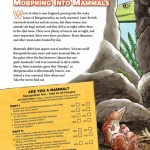test
This was just too cute (and funny!) not to share. I came across a blog in Scientific American that discussed a "standardized test" created by Hannah Bonner, illustrator and children's writer, to help determine whether someone (or some creature) is a mammal:
Excerpt from "When Dinos Dawned, Mammals Got Munched, and Pterosaurs Took Flight"
The test is part of her book called "When Dinos Dawned, Mammals Got Munched, and Pterosaurs Took Flight." What a great educational tool. It is published by National Geographic Children's Books. Kudos to you Hannah!
Source:
Scientific American
"The views of space and time which I wish to lay before you have sprung from the soil of experimental physics, and therein lies their strength. They are radical. Henceforth space by itself, and time by itself, are doomed to fade away into mere shadows, and only a kind of union of the two will preserve an independent reality." -Hermann Minkowski
When it comes to gravity, you probably think you understand it pretty well.
Image credit: Heavens Above, via http://heavens-above.com/.
Everything with mass (or energy) attracts everything else with mass-or-energy, explaining everything from falling…
Students and laypeople alike often view biotech patents with baffled disbelief. How is it possible to patent bacteria? Mice? Cell types and DNA sequences? How can someone else "own" gene sequences that all of us have carried inside our bodies since birth?
Honestly, as a biologist, the concept of patenting a gene doesn't really throw me for a loop. Think about it: although we all have genes, we can't read them unless we use a variety of lab techniques, many of them patented. In turn, reading the sequence isn't any use unless we know why we care - that this gene is relevant and can be used to…

